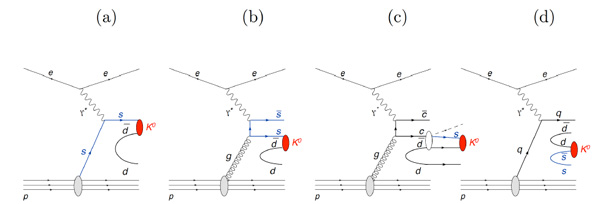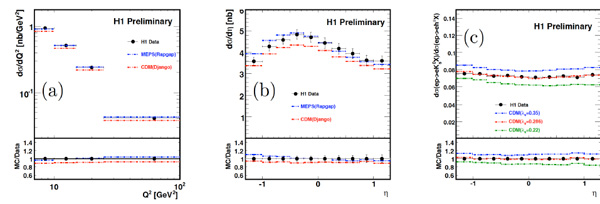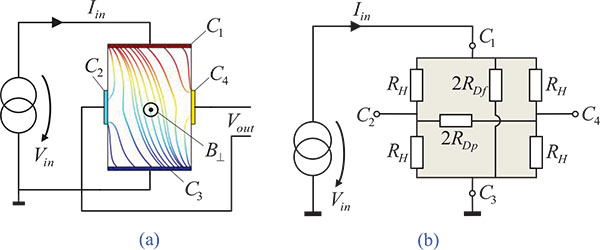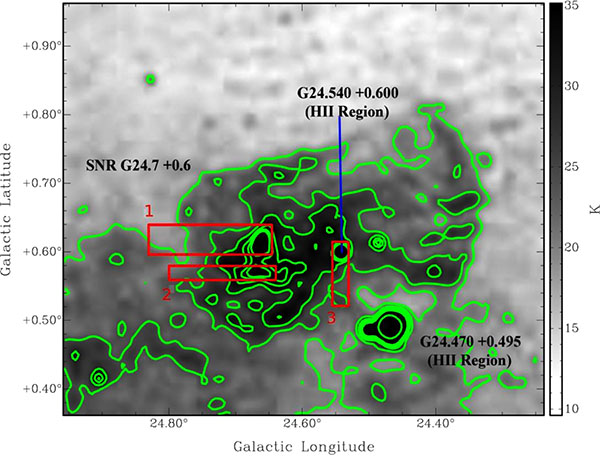RESEARCH ARTICLE
Strangeness Production in Deep-Inelastic ep Scattering at HERA §
Khurelbaatar Begzsuren*
Article Information
Identifiers and Pagination:
Year: 2014Volume: 1
Issue: Suppl 1: M6
First Page: 48
Last Page: 51
Publisher Id: PHY-1-48
DOI: 10.2174/1874843001401010048
Article History:
Received Date: 25/11/2013Revision Received Date: 25/12/2013
Acceptance Date: 26/12/2013
Electronic publication date: 31/12/2014
Collection year: 2014
open-access license: This is an open access article licensed under the terms of the Creative Commons Attribution Non-Commercial License (http://creativecommons.org/licenses/by-nc/3.0/) which permits unrestricted, non-commercial use, distribution and reproduction in any medium, provided the work is properly cited.
Abstract
The production of neutral strange hadrons is studied using deep-inelastic events measured with the H1 detector at HERA. The measurements of and productions are made in two regions of phase space defined by the negative four-momentum transferred squared of the photon, 7 < Q2 < 100GeV2 and the inelasticity 0.1 < y < 0.6 for the and 145 < Q2 < 20000GeV2 and 0.2 < y < 0.6 for the Λ . and production cross sections are determined. Differential ratios of production to charged hadron production are measured. Differential yields per event are determined. The Λ − asymmetry is measured and found to be consistent with zero. Predictions of leading order Monte Carlo programs are compared to data.
PACS number(s): 04.40.Nr, 04.70.Bw, 11.27.+d.
1. INTRODUCTION
The measurement of strange particle production in high energy collisions provides valuable information for understanding Quantum Chromodynamics (QCD) in the perturbative and non-perturbative regime. In neutral current deep-inelastic ep scattering (DIS) at HERA four different processes depicted in Fig. (1) contribute to strange hadron production.
Strange quarks may originate directly from the strange sea of the proton (Fig. 1a), from boson-gluon-fusion (BGF, Fig. 1b), from the decays of heavy flavoured hadrons (Fig. 1c) and from the creation of pairs in the non-perturbative fragmentation process (Fig. 1d). The latter process is the dominant source for strange hadron production. In the modelling of the fragmentation process the suppression of pairs due to the mass of the strange quark is generally controlled by the strangeness suppression factor λs [1, 2]. Especially, the ratio of to charged particles should strongly depends on this quark mass effect.
This paper presents new measurements of production at low Q2 and Λ production at high Q2. Results are presented on and production cross sections, on the ratio of production to charged particles production measured in the same phase space region, on Λ yields normalised to DIS cross sections, and on the asymmetry. The measurements are shown as a function of several observables characterising the DIS kinematics and the strange particles production dynamics in the laboratory frame. The results are compared with predictions obtained from leading order Monte Carlo calculations, based on matrix elements with parton shower simulation. The rôle of strangeness suppression on hadrons with strangeness is investigated.
2. SELECTION OF HADRON CANDIDATES
The data used in the analyses correspond to an integrated luminosity of 109pb-1 in case of production and 340p-1 in case of Λ production and were collected with the H1 detector [3] in the years 2004 to 2007 when protons with an energy of 920 GeV collided with electrons1 with an energy of 27.6 GeV producing a centre-of-mass energy of = 319 GeV. The kinematics of the scattering process at HERA are described using the Lorentz invariant variables Q2 denoting the square of the photon virtuality, the inelasticity in the proton rest frame y and Bjorken scaling variable x. At fixed only two of these variables are independent because of Q2 = xys. The following kinematic ranges are used in the analyses: 7 < Q2 < 100GeV2 and 0.1 < y < 0.6 for the and 145 < Q2 < 20000GeV2 and 0.2 < y < 0.6 for the Λ (see Table 1).
Phase space regions explored in the analyses of and Λ production, respectively.
| DIS Kinematics | |
| 7 < Q2 < 100GeV2, 0.1 < y < 0.6 | |
| Λ | 145 < Q2 < 20000GeV2, 0.2 < y < 0.6 |
| Hadron Kinematics | |
| 0.5 < pT < 3.5GeV2 , -1.3 < η < 1.3 | |
| Λ | pT < 0.3GeV2 , -1.5 < η < 1.5 |
The mesons and Λ baryons2 are measured by the kinematic reconstruction of their decays and , respectively. The number of mesons and Λ baryons is obtained by fitting the invariant mass spectra with the sum of a signal and background function. For the signal function the skewed t-student function is used while the background shape is described by a threshold function with exponential damping. In total approximately 290000 mesons and 7000 baryons are reconstructed in the phase space given in Table1. The fitted and Λ masses agree with the world average [4].
3. RESULTS AND DISCUSSION
3.1. Inclusive Cross Sections
The visible inclusive production cross sections measured in the kinematic region defined in Table1, are
using a strangeness suppression factor of λs the models RAPGAP [5] and DJANGOH [6] predict cross sections of 10.93 nb and 9.88 nb, respectively, in reasonable agreement with the measurement. The cross section predictions for production from the MEPS and CDM [7]models are shown in Table2 for two values of the strangeness suppression parameter λs. The measured inclusive cross section is close to the CDM prediction with λs = 0.22 and λs = 0.286 to the MEPS prediction with .
Monte Carlo predictions for different settings of the strangeness suppresion factor λs
| λs = 0.220 | λs = 0.286 | |
| CDM | 136 pb | 161 pb |
| MEPS | 120 pb | 144 pb |
3.2. Differential Cross Sections
Differential cross sections of and Λ production are shown in Figs. (2a, b, 3a) as a function of Q2, and as a function of the kinematic variable of the neutral strange hadrons in the laboratory frame, η along with the predictions of the MEPS and CDM models. The cross sections fall rapidly as Q2 grows. The figures also include the ratios of predicted to measured cross sections for a better shape comparison. Apart from small normalisation differences the models describe the shapes of the measured cross sections as a function of Q2 and η reasonably well.
3.3. Ratio of Production to Charged Particle Production
By normalising the production cross section to the cross section of charged particle production many model dependent uncertainties, like the cross section dependence on proton PDFs, cancel thus enhancing the sensitivity to details of the fragmentation process. In Fig. (2c) the ratio of production to the cross section charged particle procduction is shown as a function of η in comparison to the expectations from DJANGOH using three different values of λs ranging from 0.220 to 0.35. The ratio in η is well described by the model in shape and a high sensitivity on λs is observed in the absolute value of this ratio, demonstrating the clear potential of using this ratio for extracting the strangeness suppression factor λs.
3.4. Λ Production to DIS Cross Section Ratio
In Fig. (3b) the ratio ofproduction to DIS cross section is shown as a function of Q2 in comparison to the expectations from RAPGAP and DJANGOH both using λs = 0.286 and λs = 0.220. The DJANGOH prediction with λs = 0.286 yields the worst description of the data by overshooting them significantly independent of Q2. For the same strangeness suppression factor also RAPGAP tends to yield ratios larger than observed in data for Q2 < GeV2. The best description is provided by DJANGHO using λs = 0.220.
3.5. Asymmetries
The asymmetry is defined as:
This observable could shed light on the mechanism of baryon number transfer in ep scattering. A significant positive asymmetry would be an indication for the baryon number transfer from the proton to the Λ baryon. If present such an effect should be more pronounced in the positive region in the laboratory frame. For the kinemaic region defined in table 1 the asymmetry is measured to be
In Fig. (3c) the asymmetry AΛ is shown as a function of Q2. The data show no evidence for a non-vanishing asymmetry in the phase space region investigated.
CONCLUSION
This paper presents a study of inclusive production of and Λ in DIS at low Q2 and Λ high Q2 measured with the H1 detector at HERA. The cross sections of and Λ production are measured as a function of the DIS kinematic variable Q2 and of strange hadron production variables in the laboratory frame. In addition results on the ratio of production cross section to the charged particle cross section, the Λ production to DIS cross section ratio and the asymmetry are presented. The measurements are compared to model predictions of DJANGOH, based on the colour-dipol model (CDM) and RAPGAP based on DGLAP matrix element calculations supplemented with parton showers (MEPS). Within the uncertainties both models provide a reasonable description of the data. The sensitivity of the ratio of to charged particle production cross sections on the strangeness suppression factor λs is demonstrated, however, a detailed understanding of concurrent processes of production is mandatory prior to the determination of λs. The measured visible Λ cross section is found to be described best by the CDM using and the MEPS model using λs = 0.220 . When investigating theproduction to DIS cross section ratio the best agreement is observed for the CDM with λs = 0.220. The asymmetry is found to be consistent with zero.
CONFLICT OF INTEREST
The author confirms that this article content has no conflicts of interest.
NOTES
1 In this paper "electron" is used to denote both electron and positron.
2 Unless otherwise noted, charge conjugate states are always implied.
ACKNOWLEDGEMENS
Declared none.















